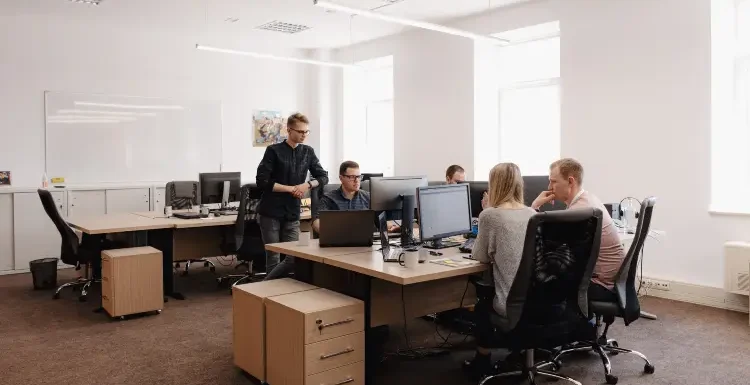
The design of your office space significantly impacts employee productivity, client perception, and overall workplace morale. A well-thought-out office environment strikes a balance between being inviting and being functional. Whether you’re setting up a new workspace or renovating an existing one, it’s essential to consider aesthetics, functionality, and the psychological impact of your design choices.
Why Office Design Matters
Office design goes beyond visual appeal; it directly influences how people work, interact, and feel. An environment that encourages creativity, collaboration, and well-being can lead to better job satisfaction and better business outcomes. On the other hand, a badly designed workspace can result in discomfort, distraction, and diminished productivity.
Research from workplace studies consistently shows that factors like lighting, acoustics, temperature, layout, and access to nature affect employee engagement and health. Therefore, designing with intention is crucial to create a space that meets your team’s and your business’s needs.
Layout: Open vs. Private
One of the most debated aspects of office design is layout. Open-plan offices encourage communication and teamwork, making them ideal for creative industries. However, they can also lead to noise and distractions. On the other end of the spectrum, traditional private offices offer quiet, focused environments but may hinder collaboration.
The best approach often lies in a hybrid model—incorporating open spaces for group work alongside quiet zones or private rooms for concentrated tasks. Use modular furniture and movable partitions to create adaptable spaces that fit a variety of work styles.
Lighting: Natural and Artificial
Lighting is crucial in both the mood and efficiency of employees. Poor lighting can lead to eye strain, fatigue, and even depression. Natural light is ideal and should be maximized wherever possible. Position desks near windows and use sheer blinds to reduce glare without blocking sunlight.
In areas without access to natural light, opt for LED lighting that mimics daylight. Adjustable task lighting can also be a good addition, allowing employees to control their own lighting levels for comfort.
Color Psychology
Color influences mood, focus, and energy levels. Neutral tones like whites, grays, and beiges promote calmness and professionalism, making them perfect for general areas. Blues can enhance focus, while greens are restful for the eyes and evoke a sense of balance. Bright accents like orange or yellow can stimulate creativity and energize collaborative spaces.
Avoid over-saturating your office with intense colors—use them instead as accents in furnishings, artwork, or feature walls.
Furniture and Ergonomics
Ergonomic furniture is a non-negotiable element of a practical office. Investing in adjustable chairs, sit-stand desks, and monitor arms helps prevent repetitive strain injuries and encourages better posture.
In addition to functionality, choose furniture that complements the overall aesthetic of your space. Modern, streamlined furniture with clean lines often works well in contemporary offices, while natural wood tones can warm up more industrial settings.
Acoustic Considerations
Noise is one of the biggest complaints in modern offices. Soundproofing measures such as acoustic panels, carpets, and ceiling baffles can drastically reduce echo and external noise. Creating designated quiet zones and using soft furnishings can also help absorb sound.
Glass walls or partitions are excellent for maintaining an open look while still providing acoustic privacy. In particular, office doors with glass offer a stylish solution that allows natural light to flow through while maintaining separation and reducing noise between rooms.
Biophilic Design
Biophilic design, which integrates natural elements into the workplace, has been shown to reduce stress and boost cognitive function. Adding plants, incorporating natural materials like wood and stone, and using nature-inspired patterns can all contribute to a calming, productive atmosphere.
Indoor plants, green walls, and water features are not only visually appealing but also improve air quality. Consider including potted plants at each desk, hanging greenery from ceilings, or even creating dedicated green breakout areas.
Branding and Culture
Your office is a reflection of your brand and culture. Use design elements that align with your company’s values and mission. Displaying your logo, using brand colors, or featuring your company’s story in wall art or murals helps to reinforce your identity to both employees and visitors.
Showcasing employee achievements, community involvement, or historical milestones within the office can also strengthen internal culture and pride.
Technology Integration
A modern office should seamlessly incorporate technology without cluttering the workspace. Provide ample charging stations, cable management systems, and wireless connectivity. Conference rooms should be equipped with video conferencing tools, smartboards, and sound systems that support both in-person and remote collaboration.
Consider “hot desking” setups where employees use laptops and shared docking stations, offering flexibility and reducing the need for assigned desks.
Safety and Accessibility
A practical office must also be safe and accessible. Ensure walkways are clear and that emergency exits are marked and accessible. Incorporate ramps and automatic doors for those with mobility challenges. Adjustable-height desks, visual alarms, and tactile indicators for the visually impaired help create an inclusive environment.
Don’t forget air quality and ventilation—especially in a post-pandemic world, these factors play a crucial role in employee health and comfort.
